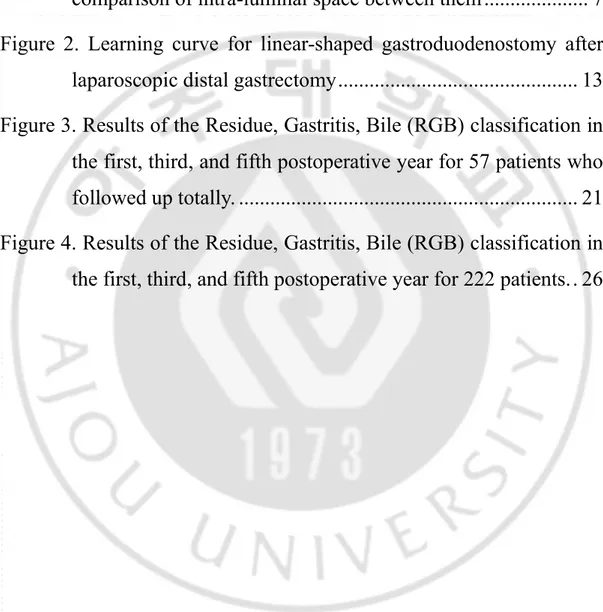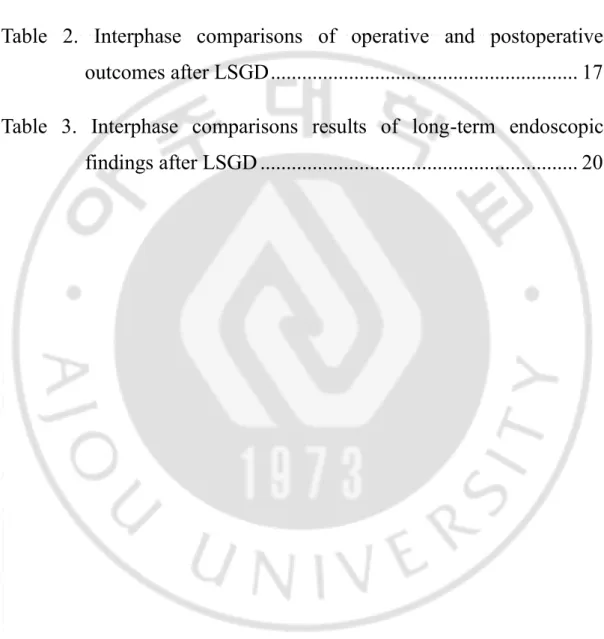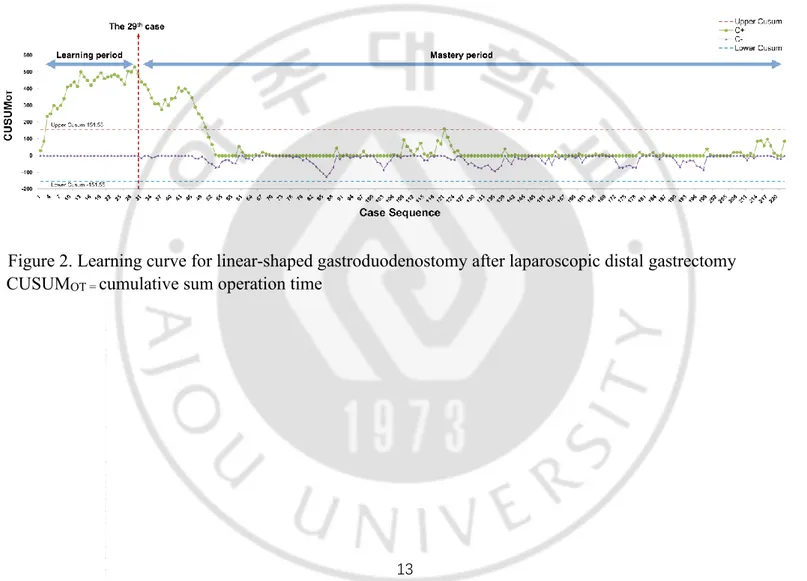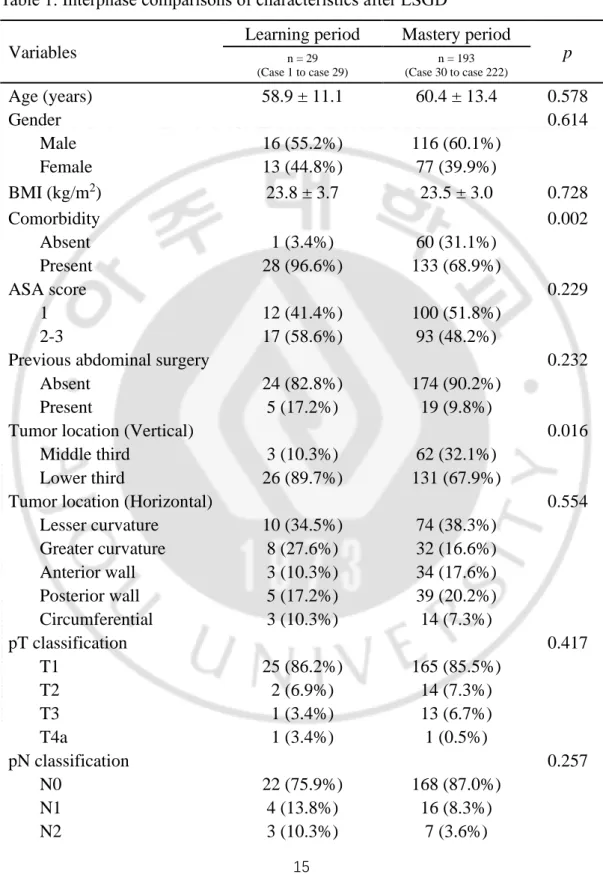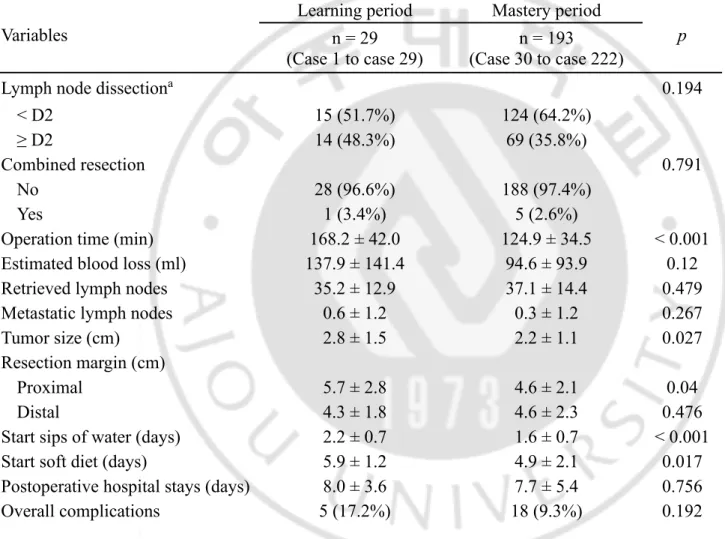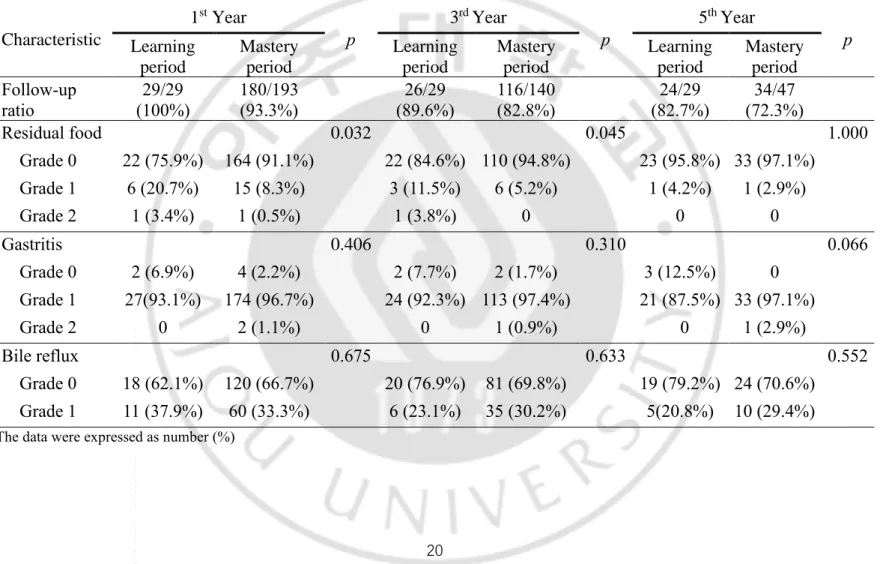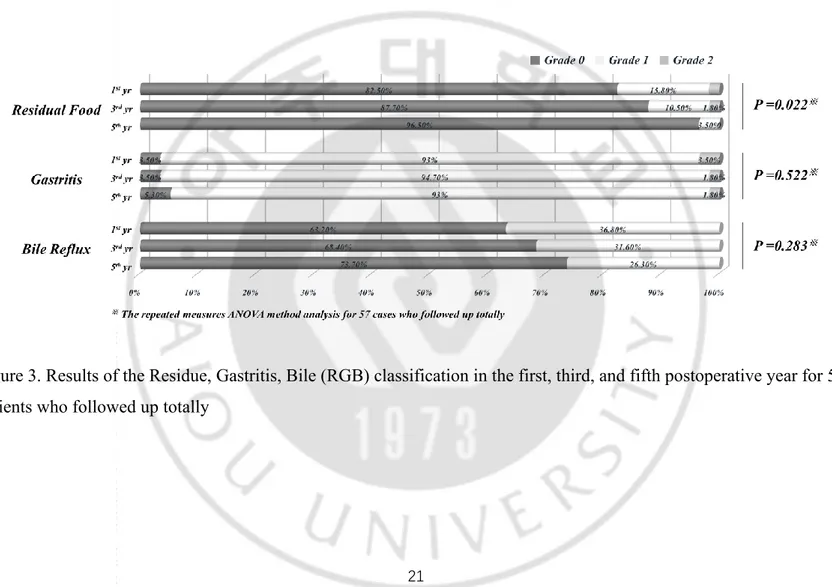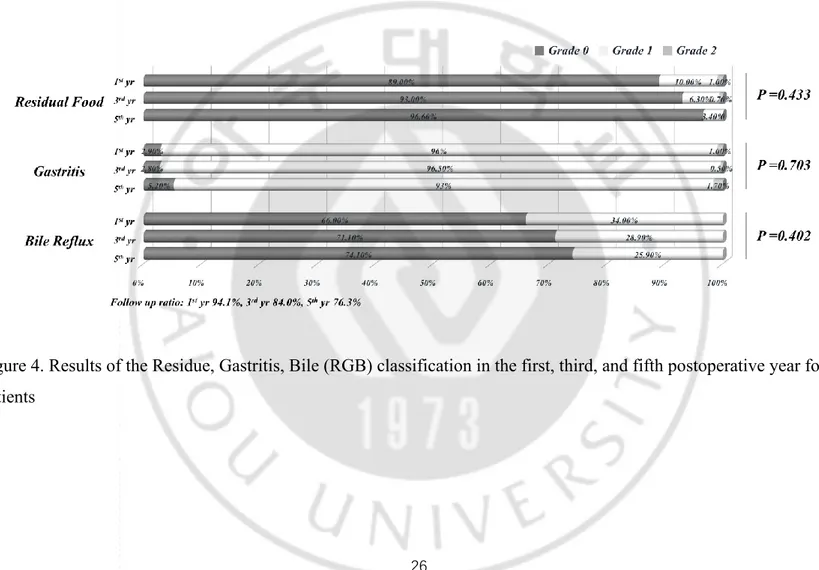저작자표시-비영리-변경금지 2.0 대한민국 이용자는 아래의 조건을 따르는 경우에 한하여 자유롭게 l 이 저작물을 복제, 배포, 전송, 전시, 공연 및 방송할 수 있습니다. 다음과 같은 조건을 따라야 합니다: l 귀하는, 이 저작물의 재이용이나 배포의 경우, 이 저작물에 적용된 이용허락조건 을 명확하게 나타내어야 합니다. l 저작권자로부터 별도의 허가를 받으면 이러한 조건들은 적용되지 않습니다. 저작권법에 따른 이용자의 권리는 위의 내용에 의하여 영향을 받지 않습니다. 이것은 이용허락규약(Legal Code)을 이해하기 쉽게 요약한 것입니다. Disclaimer 저작자표시. 귀하는 원저작자를 표시하여야 합니다. 비영리. 귀하는 이 저작물을 영리 목적으로 이용할 수 없습니다. 변경금지. 귀하는 이 저작물을 개작, 변형 또는 가공할 수 없습니다.
Doctoral Thesis in Medicine
The learning curve of linear-shaped
gastroduodenostomy associated with
totally laparoscopic distal gastrectomy
by
WANG BO
Ajou University Graduate School
Major in Medicine
The learning curve of linear-shaped
gastroduodenostomy associated with
totally laparoscopic distal gastrectomy
Sang-Uk Han,
M.D., Ph.D.
Advisor
I submit this thesis as the
Doctoral thesis in Medicine
February 2020
Ajou University Graduate School
Major in Medicine
Department of Medical Sciences
WANG BO
The Doctoral thesis of WANG BO in Medicine
is hereby approved.
Thesis Defense Committee President
11111111111111111111
Wook Hwan Kim
Member
1111111wook hwan kim
Sang-Uk Han
Member
1S ng uk han
Kyong-Hwa Jun
Member
111111111111111111111
Seung Yeop Oh
Member
111111111111111111111
Hoon Hur
Ajou University Graduate School
i
ACKNOWLEDGEMENTS
Upon the completion of this thesis, I am grateful to those who have offered me encouragement and support during the Ph.D. course. First, special acknowledgment is given to my respectable supervisor, Prof. Sang-Uk Han, whose patient instruction and constructive suggestions are beneficial to me a lot. Second, thanks go to all the members of Gastrointestinal Department, particularly Prof. Sang-Yong Son and Prof. Hoon Hur, who have taught me all the details how to conduct the clinical study and generous support during these years. Third, I would like to express the most heartfelt gratitude to my wife who have provided me great support. What is more, I would like to present my thanks to all my Chinese Korean Nationality friends, Li Hongri, Jin Ming, et al..
Thank the supports, a grant from the National R&D Program for Cancer Control, Ministry of Health and Welfare, Republic of Korea (1320270) and a grant from the Ajou University Medical Center (2016-C0460-00061).
Thank Ajou University Hospital. Thank Ajou University.
ii
ABSTRACT
Background: Linear-shaped gastroduodenostomy (LSGD) is a new method of
intracorporeal reconstruction that is simpler to perform and associated with a lower rate of bile reflux than delta-shaped anastomosis. Here, we analyzed the learning curve of LSGD in totally laparoscopic distal gastrectomy.
Methods: The cumulative sum method was used to retrospectively analyze
consecutive gastric cancer patients undergoing intracorporeal gastroduodenostomy after distal gastrectomy between January 2009 and May 2016. The duration of surgery, postoperative complications, hospital stay, and endoscopic findings in the postoperative period and the first, third, and fifth year were evaluated according to the two phases of the learning curve (learning period versus mastery period).
Results: Data from 222 patients were included in the analysis. The LSGD learning
period was 29 cases. The surgical time in mastery period was significantly shorter than the learning period (124.9 ± 34.5 versus 168.2 ± 42.0 min, p < 0.001). The incidence of minor complications was significantly reduced after the learning period (p = 0.041), although there was no statistically significant difference in the rate of major complications. The long-term endoscopic findings showed that the presence of residual food decreased over the time (p = 0.022).
Conclusions: LSGD can be mastered easily after a reasonable number of cases and
was associated with safe and satisfactory short- and long-term outcomes before and after learning curve.
iii
TABLE OF CONTENTS
ACKNOWLEDGEMENTS --- i
ABSTRACT --- ii
TABLE OF CONTENTS --- iii
LIST OF FIGURES --- iv
LIST OF TABLES --- v
I. INTRODUCTION --- 1
II. MATERIALS AND METHODS --- 4
1. Patients --- 5
2. LSGD surgical technique --- 5
3. Endoscopic surveillance and classification of endoscopic findings --- 8
4. CUSUM and statistical analysis --- 8
5. Ethics statement --- 10
III. Results --- 11
1. CUSUM analysis of the LSGD learning curve --- 12
2. Comparison of patients’ characteristics and short-term outcomes --- 14
3. Comparison of long-term endoscopic findings --- 19
IV. DISCUSSION --- 22
V. CONCLUSIONS --- 27
iv
LIST OF FIGURES
Figure 1. The schematic illustration for LSGD and DSGD, and the
comparison of intra-luminal space between them ... 7
Figure 2. Learning curve for linear-shaped gastroduodenostomy after
laparoscopic distal gastrectomy ... 13
Figure 3. Results of the Residue, Gastritis, Bile (RGB) classification in
the first, third, and fifth postoperative year for 57 patients who
followed up totally. ... 21
Figure 4. Results of the Residue, Gastritis, Bile (RGB) classification in
v
LIST OF TABLES
Table 1. Interphase comparisons of characteristics after LSGD ... 15
Table 2. Interphase comparisons of operative and postoperative
outcomes after LSGD ... 17
Table 3. Interphase comparisons results of long-term endoscopic
1
2
Laparoscopic-assisted gastrectomy with perigastric lymphadenectomy for the treatment of gastric cancer was first introduced by Kitano et al. in 1994 1. As surgical techniques and devices have improved, the gastrectomy procedure has progressed from laparoscopic-assisted to a totally laparoscopic approach, and reconstruction of the digestive tract is performed intracorporeally, maximizing the benefits of minimally invasive surgery 2, 3. After distal gastrectomy, the gastrointestinal tract can be restored by a gastroduodenal anastomosis (Billroth I), gastrojejunal anastomosis (Billroth II), or a Roux-en-Y gastrojejunostomy. Among these, Billroth I reconstruction is the only anastomosis that maintains physiological food passage and prevents internal hernia, whilst retaining the ability to easily perform Endoscopic Retrograde Cholangio-Pancreatography (ERCP) examination, especially in young patients who underwent early gastric cancer surgery. However, Billroth I is not the most commonly used method of intracorporeal reconstruction due to the demanding technical requirements. After the delta-shaped gastroduodenostomy (DSGD) was first reported by Kanaya et al. in 2002 4, it became the most popular intracorporeal method of gastroduodenostomy after distal gastrectomy. However, a nationwide survey conducted by the Korean Gastric Cancer Association has shown that use of the Billroth I have decreased, possibly due to the demanding technical requirements 5. DSGD also has some limitations, being a complicated technique that is associated with a relatively high rate of anastomotic complications 6-8.
The linear-shaped gastroduodenostomy (LSGD) was developed by our institute and published in 2010 9. Our original study showed that this new approach was simple to perform and was associated with a lower rate of bile reflux than that with delta-shaped anastomosis in 201610.
Several previous papers have described the learning curve for delta-shaped anastomosis, showing that a plateau is reached after approximately 20 laparoscopic surgery procedures 11, 12. However, as the learning curve for LSGD has not previously
3
been investigated, we have conducted a study to analyze the learning curve for LSGD and to investigate the long-term endoscopic findings associated with this new procedure.
4
5
1. Patients
This was a retrospective study of data obtained between June 2009 and May 2016 at the Ajou University Hospital, South Korea, and all the cases were conducted by a single surgeon (Han SU), who had performed laparoscopic gastrectomy more than 800 cases before performing totally laparoscopic distal gastrectomy. During this period, 923 cases of laparoscopic radical distal gastrectomy with Billroth I reconstruction were conducted. Patients undergoing extracorporeal reconstruction, delta-shaped anastomosis, hand-sewn gastroduodenostomy, and other anastomosis methods were excluded from the analysis.
2. LSGD surgical technique
All patients included in the study underwent totally laparoscopic distal radical gastrectomy with intracorporeal reconstruction using the LSGD approach, which was firstly described in 2010 9, and the short-term and intermediate outcomes regarding safety and feasibility of this technique was reported in 2016 10. The great differences of this technique from DSGD are that a 60 mm endo-stapler is used for the anastomosis and that the anastomosis is made parallel between duodenal stump and gastric stump (Figure 1). Thus, the diameter or intraluminal space of anastomosis in LSGD are greater than those in DSGD,which might reduce bile reflux and gastric stasis compared to DSGD. The major procedure was conducted as follows: 1) after V-shaped liver retraction 13 and perigastric lymphadenectomy, a linear endo-stapler was introduced through the left lower assistant port, transecting the duodenum in a craniocaudal direction without 90º duodenal rotation; 2) a small entry hole was made on the superior edge of the duodenal transection line; 3) a small incision was made on the greater curvature of the remnant stomach 60 mm from the resection line; 4) the cartridge jaw of the 60 mm endoscopic linear stapler was inserted into the
6
remnant stomach; 5) the greater curvature of the remnant stomach and anterosuperior side of the duodenum were aligned and the stapler fired; 6) using another 60 mm endo-stapler to close the common entry hole 10. The perigastric lymph node stations were numbered according to the Japanese classification of gastric carcinoma 14. The extent of the lymphadenectomy was determined using the 2014 Japanese gastric cancer treatment guidelines (Version 4) 15.
7
Figure 1. The schematic illustration for LSGD and DSGD, and the comparison of intra-luminal space between them
8
3. Endoscopic surveillance and classification of
endoscopic findings
Endoscopic surveillance was performed in the first, third, and fifth years, and was performed by one of three endoscopists who were highly specialized in gastric cancer and were belonged to the Gastric Cancer Center. The entire procedure has been standardized by our institution and has been described in detail previously 10. Endoscopic findings of the remnant stomach were evaluated using the RGB (Residual food, Gastritis, Bile reflux) classification 16.
4. CUSUM and statistical analysis
The cumulative sum (CUSUM) method is a graphic approach to detecting small shifts in an overall process that can also indirectly detect data trends. The CUSUM chart plots the cumulative sum of the deviation of the raw value of each sample from the target or mean value 17. As the CUSUM chart is cumulative, even minor drifting in the process mean will cause steadily increased or decreased cumulative deviation values. In the present study, the cases were numbered chronologically from the first to the last and the formula of CUSUM operation time (CUSUMOT) was represented as follows: CUSUMOT∙max= ∑ [Xi − (µ + K) + FIR]n
i=1 and
CUSUMOT∙min=∑n [Xi − (µ − K) + FIR]
i=1 , where ii is an individual operation time, µ is the overall mean values of operation time, K is a constant representing the allowable ‘slack’ in the process and specifying the magnitude of the shift you want to detect (usually defined as half of standard deviations), and FIR is also a constant, usually equal to 0. The learning curve of LSGD regarding the operation time was represented intuitively and determined by plotting the outcomes in the CUSUM chart. There were two fluctuating lines, the upper indicates that the individual operation time was greater than the population mean and the lower indicates that it was lower
9
and, therefore, not necessary to include in the analysis. Therefore, the upper line was defined as the learning curve of LSGD. The CUSUM charts were plotted using the Excel plugin, named QI Macros, version 2018 student for Windows (KnowWare International Inc., Colorado, USA).
All the statistical analyses were performed using the Statistical Package for the Social Sciences (SPSS), version 24.0 for Windows (SPSS Inc., Chicago, USA). For quantitative data, the results are expressed as the mean ± standard deviations; for categorical data, the results are expressed as number (%). Categorical variables were analyzed by the Chi-square test or Fisher’s exact test; continuous variables were analyzed by Student’s t test. Furthermore, repeated values were analyzed by the repeated measured ANOVA method. The level for rejection of the null hypothesis was set at a p value of < 0.05.
10
5. Ethics statement
All patients provided informed consent for their information to be stored in the hospital database and used for research. The study protocol was approved by the Institutional Review Board of the Ajou University Hospital.
11
12
1. CUSUM analysis of the LSGD learning curve
The CUSUM analysis was performed to analyze the total operation times according to the experienced cases, and it showed a gradual increase until the 29th case; thereafter, it declined sharply until the 54th case (Figure 2). Therefore, the learning curve was considered as 29 cases in the present study and the cases were divided into two groups; the initial learning period (1st–29th case) and the mastery period (30th–222nd case).
13
Figure 2. Learning curve for linear-shaped gastroduodenostomy after laparoscopic distal gastrectomy CUSUMOT = cumulative sum operation time
14
2. Comparison of patients’ characteristics and short-term
outcomes
Patient characteristics according to the learning curve phase are described in Table 1. It showed that the proportion of middle located tumor were significantly higher in the mastery period (p = 0.016), but no statistically significant differences in other variables between the two phases.
Operative and postoperative outcomes are shown in Table 2. The surgical time was significantly longer in the learning phase than the mastery phase (168.2 ± 42.0 versus 124.9 ± 34.5 min, p < 0.001). During the learning period, the tumor size was bigger and gained more wider proximal resection margin compared with mastery period (p = 0.027 and p = 0.040, respectively). There were statistically significant differences regarding time to restoration of diet between the two phases (sips of water: 2.2 ± 0.7 versus 1.6 ± 0.7 days, p < 0.001; soft diet: 5.9 ± 1.2 vs. 4.9 ± 2.1 days, p = 0.017). The rate of minor complications also differed significantly between the two phases, 13.8% in learning period rather than 3.6% in mastery period (p = 0.041).
15
Table 1. Interphase comparisons of characteristics after LSGD Variables
Learning period Mastery period
p n = 29 (Case 1 to case 29) n = 193 (Case 30 to case 222) Age (years) 58.9 ± 11.1 60.4 ± 13.4 0.578 Gender 0.614 Male 16 (55.2%) 116 (60.1%) Female 13 (44.8%) 77 (39.9%) BMI (kg/m2) 23.8 ± 3.7 23.5 ± 3.0 0.728 Comorbidity 0.002 Absent 1 (3.4%) 60 (31.1%) Present 28 (96.6%) 133 (68.9%) ASA score 0.229 1 12 (41.4%) 100 (51.8%) 2-3 17 (58.6%) 93 (48.2%)
Previous abdominal surgery 0.232
Absent 24 (82.8%) 174 (90.2%)
Present 5 (17.2%) 19 (9.8%)
Tumor location (Vertical) 0.016
Middle third 3 (10.3%) 62 (32.1%)
Lower third 26 (89.7%) 131 (67.9%)
Tumor location (Horizontal) 0.554
Lesser curvature 10 (34.5%) 74 (38.3%) Greater curvature 8 (27.6%) 32 (16.6%) Anterior wall 3 (10.3%) 34 (17.6%) Posterior wall 5 (17.2%) 39 (20.2%) Circumferential 3 (10.3%) 14 (7.3%) pT classification 0.417 T1 25 (86.2%) 165 (85.5%) T2 2 (6.9%) 14 (7.3%) T3 1 (3.4%) 13 (6.7%) T4a 1 (3.4%) 1 (0.5%) pN classification 0.257 N0 22 (75.9%) 168 (87.0%) N1 4 (13.8%) 16 (8.3%) N2 3 (10.3%) 7 (3.6%)
16 N3 0 2 (1.0%) pStage* 0.376 IA 21 (72.4%) 154 (79.8%) IB 5 (17.2%) 17 (8.8%) IIA 1 (3.4%) 13 (6.7%) IIB 1 (3.4%) 5 (2.6%) IIIA 0 3 (1.6%) IIIB 1 (3.4%) 1 (0.5%) IIIC 0 0
The data were expressed as mean ± standard deviation or number (%).
ASA American Society of Anesthesiologists score, BMI Body mass index
17
Table 2. Interphase comparisons of operative and postoperative outcomes after LSGD Variables
Learning period Mastery period
p
n = 29 (Case 1 to case 29)
n = 193 (Case 30 to case 222)
Lymph node dissectiona 0.194
< D2 15 (51.7%) 124 (64.2%)
≥ D2 14 (48.3%) 69 (35.8%)
Combined resection 0.791
No 28 (96.6%) 188 (97.4%)
Yes 1 (3.4%) 5 (2.6%)
Operation time (min) 168.2 ± 42.0 124.9 ± 34.5 < 0.001
Estimated blood loss (ml) 137.9 ± 141.4 94.6 ± 93.9 0.12
Retrieved lymph nodes 35.2 ± 12.9 37.1 ± 14.4 0.479
Metastatic lymph nodes 0.6 ± 1.2 0.3 ± 1.2 0.267
Tumor size (cm) 2.8 ± 1.5 2.2 ± 1.1 0.027
Resection margin (cm)
Proximal 5.7 ± 2.8 4.6 ± 2.1 0.04
Distal 4.3 ± 1.8 4.6 ± 2.3 0.476
Start sips of water (days) 2.2 ± 0.7 1.6 ± 0.7 < 0.001
Start soft diet (days) 5.9 ± 1.2 4.9 ± 2.1 0.017
Postoperative hospital stays (days) 8.0 ± 3.6 7.7 ± 5.4 0.756
18 Minor complications 4 (13.8%) 7 (3.6%) 0.041 Wound infection 2 (7.0%) 1 (0.5%) Fluid collection 1 (0.5%) Intra-abdominal bleeding 1 (0.5%) Pancreatitis 1 (3.4%) 2 (1.0%) Pulmonary 1 (3.4%) 2 (1.0%) Major complications* 1 (3.4%) 11 (5.6%) 0.617 Fluid collection 1 (0.5%) Anastomotic leakage 1 (3.4%) 3 (1.5%) Anastomotic stenosis† 3 (1.5%) Pancreatic fistula 2 (1.0%) Intestinal obstruction 2 (1.0%)
Operative mortality (within 30
days) 0 0 NA
The data were expressed as mean ± standard deviation or number (%).
a According to the Japanese gastric cancer treatment guideline 2010
* The major complication was defined according to the Clavian-Dindo classification ≧ III. †A half-covered stent was applied and removed after about 2-4 weeks endoscopically
19
3. Comparison of long-term endoscopic findings
An interphase comparison of the long-term endoscopic findings in the first, third, and fifth postoperative year is shown in Table 3; There were significant difference in residual food between learning and mastery period in the first and third year, but the difference disappeared at the fifth year postoperatively. There were no significant differences in degree of gastritis, and bile reflex in the follow-up period. However, in 57 cases for whom follow-up data were available for the entire period, the residual food classification improved significantly over the 5-year period (p = 0.022; Figure 3).
20
Table 3. Interphase comparisons results of long-term endoscopic findings after LSGD Characteristic 1st Year p 3rd Year p 5th Year p Learning period Mastery period Learning period Mastery period Learning period Mastery period Follow-up ratio 29/29 (100%) 180/193 (93.3%) 26/29 (89.6%) 116/140 (82.8%) 24/29 (82.7%) 34/47 (72.3%) Residual food 0.032 0.045 1.000 Grade 0 22 (75.9%) 164 (91.1%) 22 (84.6%) 110 (94.8%) 23 (95.8%) 33 (97.1%) Grade 1 6 (20.7%) 15 (8.3%) 3 (11.5%) 6 (5.2%) 1 (4.2%) 1 (2.9%) Grade 2 1 (3.4%) 1 (0.5%) 1 (3.8%) 0 0 0 Gastritis 0.406 0.310 0.066 Grade 0 2 (6.9%) 4 (2.2%) 2 (7.7%) 2 (1.7%) 3 (12.5%) 0 Grade 1 27(93.1%) 174 (96.7%) 24 (92.3%) 113 (97.4%) 21 (87.5%) 33 (97.1%) Grade 2 0 2 (1.1%) 0 1 (0.9%) 0 1 (2.9%) Bile reflux 0.675 0.633 0.552 Grade 0 18 (62.1%) 120 (66.7%) 20 (76.9%) 81 (69.8%) 19 (79.2%) 24 (70.6%) Grade 1 11 (37.9%) 60 (33.3%) 6 (23.1%) 35 (30.2%) 5(20.8%) 10 (29.4%)
21
Figure 3. Results of the Residue, Gastritis, Bile (RGB) classification in the first, third, and fifth postoperative year for 57 patients who followed up totally
22
23
Currently, the DSGD is still a popular reconstruction approach for intracorporeal Billroth I after totally laparoscopic distal gastrectomy. However, it has been reported with relatively high rate of anastomosis-related complications 6-8. As like we previously reported, we developed LSGD to overcome the technical difficulty of DSGD in 2009 and reported promising outcomes to reduce bile reflux and gastric stasis compared with DSGD in 2006. However, this technique has not been popular because only a few papers with modified method or different name have been reported 18, 19. In addition, there was no report on learning curve of this technique, which make the surgeons hesitating to perform this novel technique for intracorporeal Billroth I anastomosis. Thus, we analyzed the learning curve of LSGD This is the first study to describe the LSGD learning curve, demonstrating this method to be a safe approach that can be mastered rapidly; short-term surgical outcomes and long-term endoscopic findings after totally laparoscopic distal gastrectomy were acceptable, even during the learning period.
CUSUM analysis of the learning curve showed that, the number of cases required to master the LSGD was considered as 29, it was shorter than in other previous studies. Huang et al. 20 reported the learning period for DSGD was 41 cases. Once into the mastery period, the surgical time stabilized at around 124.9 ± 34.5 min, it was also shorter than that in previous studies (393.9 ± 70.8 min reported by Huang et al. 20, and 142 ± 19 min reported by Jeong et al. 11).
The major complication rate showed no significant difference between the phases. The anastomosis-related complication rate associated with LSGD was relatively low even during the learning period (3.4%). These data are comparable with DSGD reconstruction method. Kanaya et al 12 reported the rate of anastomosis-related complication in the initial 100 consecutive procedures was 4.1%, even with an additional suture, the anastomotic leakage remained higher than that with LSGD
24
(7.1% versus 1.5%) 7. Compared with other overlap reconstruction methods, Watanabe Y et al 19 reported the rate of anastomotic complication was 3.6%, the rate of anastomotic complication of LSGD was also acceptable. In light of inherent safety of LSGD method, overall complication rate was comparable as 17.2 % and it was possible to lower it by mastering this technique in only 29 cases (9.3 % in the mastery period).
The long-term endoscopic findings showed there were no significant differences between the two phases except the residue in the first and third postoperative year, the rate of food residue was higher in learning period than that in master period. We speculated thatthe reason for gastric stasis was due to the closing direction of the common entry hole. The ‘parallel direction to duodenum’ approach to close the common entry hole which had been performed in the initial period, later we changed the closing direction from parallel to tangential to maintain the intraluminal space effectively. However, this difference of residual food could ameliorate over the time apparently. Compared with DSGD used in the study of Kanaya et al 12, the incidence of endoscopic findings in the first postoperative year was lower in our study (residual food ≥ grade 1, 28% versus 11%, respectively; gastritis ≥ grade 2, 18% versus 1%, respectively; presence of bile reflux, 73.5% versus 34%). In the present study, the follow-up ratio in the first year postoperatively was 94.1%, which was higher than that of the Kanaya et al study (83.0%) (Figure 4). We suggest that larger anastomosis lumen and these downward-straightforward structural alignments between the remnant stomach and the duodenum may facilitate the gastric food passage into the duodenum and reduce the incidence of gastritis and bile reflux in the stomach remnant, as we have described previously 10.
The present study had some limitations. Firstly, all procedures in this study were undertaken by a single surgeon and we did not analyze the pure anastomotic time but total operation time for the learning curve. Therefore, our results should be
25
interpreted carefully and applied in a clinical practice. Secondly, although the major complication rate between the two phases showed no statistically significant differences, there were some differences in patient comorbidity, and these may have had a minimal effect on the results. Thirdly, we did not introduce the risk-adjusted CUSUM method, due to the focus being on functional and surgical outcomes. Finally, the whole procedure was performed by a single experienced surgeon, so surgical failure (defined as intraoperative mortality or conversion to open gastrectomy due to the technical problems) did not occur, meaning that risk-adjusted CUSUM was not necessary 21-23.
26
Figure 4. Results of the Residue, Gastritis, Bile (RGB) classification in the first, third, and fifth postoperative year for 222 patients
27
28
The LSGD method was a safe, simple, and feasible approach to intracorporeal
anastomosis. Furthermore, it could be mastered easily after a reasonable number of cases and was associated with satisfactory short-term surgical outcomes and long-term endoscopic findings.
29
REFERENCES
1. Kitano S, Iso Y, Moriyama M, Sugimachi K. Laparoscopy-assisted Billroth I gastrectomy. Surgical laparoscopy & endoscopy. 1994;4(2):146-148. 2. Kinoshita T, Uyama I, Terashima M, Noshiro H, Nagai E, Obama K,
Tamamori, Y, Nabae, T, Honda, M, Abe, T. Long-term Outcomes of Laparoscopic Versus Open Surgery for Clinical Stage II/III Gastric Cancer: A Multicenter Cohort Study in Japan (LOC-A Study). Ann Surg. 2018. 3. Lee HH, Song KY, Lee JS, Park SM, Kim JJ. Delta-shaped anastomosis, a
good substitute for conventional Billroth I technique with comparable long-term functional outcome in totally laparoscopic distal gastrectomy. Surg Endosc. 2015;29(9):2545-2552.
4. Kanaya S, Gomi T, Momoi H, Tamaki N, Isobe H, Katayama T, Wada, Y, Ohtoshi, M. Delta-shaped anastomosis in totally laparoscopic billroth i gastrectomy: new technique of intraabdominal gastroduodenostomy11No competing interests declared. Journal of the American College of Surgeons. 2002;195(2):284-287.
5. Information Committee of Korean Gastric Cancer Association. Korean Gastric Cancer Association Nationwide Survey on Gastric Cancer in 2014. J Gastric Cancer. 2016;16(3):131-140.
6. Lee SW, Tanigawa N, Nomura E, Tokuhara T, Kawai M, Yokoyama K, Hiramatsu, M, Okuda, J, Uchiyama, K. Benefits of intracorporeal gastrointestinal anastomosis following laparoscopic distal gastrectomy. World J Surg Oncol. 2012;10:267.
7. Noshiro H, Iwasaki H, Miyasaka Y, Kobayashi K, Masatsugu T, Akashi M, Ikeda, O. An additional suture secures against pitfalls in delta-shaped
30
gastroduodenostomy after laparoscopic distal gastrectomy. Gastric Cancer. 2011;14(4):385-389.
8. Okabe H, Obama K, Tsunoda S, Tanaka E, Sakai Y. Advantage of completely laparoscopic gastrectomy with linear stapled reconstruction: a long-term follow-up study. Ann Surg. 2014;259(1):109-116.
9. Song HM, Lee SL, Hur H, Cho YK, Han S-U. Linear-Shaped Gastroduodenostomy in Totally Laparoscopic Distal Gastrectomy. Journal of Gastric Cancer. 2010;10(2):69.
10. Byun C, Cui LH, Son SY, Hur H, Cho YK, Han SU. Linear-shaped gastroduodenostomy (LSGD): safe and feasible technique of intracorporeal Billroth I anastomosis. Surg Endosc. 2016;30(10):4505-4514.
11. Jeong O, Jung MR, Park YK, Ryu SY. Safety and feasibility during the initial learning process of intracorporeal Billroth I (delta-shaped) anastomosis for laparoscopic distal gastrectomy. Surgical endoscopy. 2015;29(6):1522-1529. 12. Kanaya S, Kawamura Y, Kawada H, Iwasaki H, Gomi T, Satoh S, Uyama, I.
The delta-shaped anastomosis in laparoscopic distal gastrectomy: analysis of the initial 100 consecutive procedures of intracorporeal gastroduodenostomy. Gastric Cancer. 2011;14(4):365-371.
13. Oh DK, Hur H, Kim JY, Han S-U, Cho YK. V-shaped Liver Retraction during a Laparoscopic Gastrectomy for Gastric Cancer. Journal of Gastric Cancer. 2010;10(3):133.
14. Japanese Gastric Cancer Association. Japanese classification of gastric carcinoma: 4th English edition. Gastric Cancer. 2017; 20(1): 1–19.
15. Japanese Gastric Cancer Association . Japanese gastric cancer treatment guidelines 2010 (ver. 3). Gastric Cancer. 2011;14(2):113-123.
31
16. Makoto Kubo1 MS, Takuji Gotoda1, Hiroyuki Ono1, Mitsuhiro Fujishiro1, Daizo Saito1,Takeshi Sano2, and Hitoshi Katai2. Endoscopic evaluation of the remnant stomach after gastrectomy : proposal for a new classification. Gastric Cancer. 2002;5: 83–89.
17. Wang M, Meng L, Cai Y, Li Y, Wang i, Zhang Z, Peng, B. Learning Curve for Laparoscopic Pancreaticoduodenectomy: a CUSUM Analysis. J Gastrointest Surg. 2016;20(5):924-935.
18. Jang CE, Lee SI. Modified intracorporeal gastroduodenostomy in totally laparoscopic distal gastrectomy for gastric cancer: early experience. Ann Surg Treat Res. 2015;89(6):306-312.
19. Watanabe Y, Watanabe M, Suehara N, Saimura M, Mizuuchi Y, Nishihara K, Iwashita, T, Nakano, T. Billroth-I reconstruction using an overlap method in totally laparoscopic distal gastrectomy: propensity score matched cohort study of short- and long-term outcomes compared with Roux-en-Y reconstruction. Surg Endosc. 2019.
20. Huang K-H, Lan Y-T, Fang W-L, Chen J-H, Lo S-S, Li AF-Y,Chiou, S-H, Wu, C-W, Shyr, Y-M. Comparison of the Operative Outcomes and Learning Curves between Laparoscopic and Robotic Gastrectomy for Gastric Cancer. PLoS ONE. 2014;9(10):e111499.
21. Zhou J, Shi Y, Qian F, Tang B, Hao Y, Zhao Y, Yu, P. Cumulative summation analysis of learning curve for robot-assisted gastrectomy in gastric cancer. J Surg Oncol. 2015;111(6):760-767.
22. Biswas P, Kalbfleisch JD. A risk-adjusted CUSUM in continuous time based on the Cox model. Stat Med. 2008;27(17):3382-3406.
23. Poloniecki J, Valencia O, Littlejohns P. Cumulative risk adjusted mortality chart for detecting changes in death rate: observational study of heart surgery.
32
